Published
on 23
Nov 2020
|
All rights reserved.
|
|
|
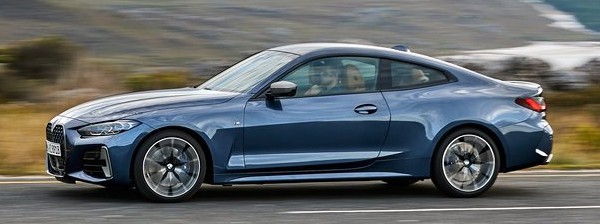
|
|
Beautiful
from some angles. Horrible from others.
|
|
Why do you buy a modern
coupe like this? For higher performance? Unlikely. Derived from the
underpinnings of the 3-Series, the 4-Series Coupe employs exactly the
same engines and gearbox. If you think losing 2 doors and a big chunk
of rear seat accommodation could save some kilograms, then you will be
disappointed to see it is actually the heavier car, outweighing its
sedan sister by 70 kg in average, despite the use of aluminum bonnet,
front fenders and doors. This is because the coupe is 59mm longer and
23mm wider, as well as some structural reinforcement added to its
chassis. You think the streamline shape should return lower drag? Wrong
again. The sleekest 4-Series Coupe has a Cd of 0.25. While pretty good,
it is 0.02 higher than the equivalent 3-Series. So all things
considered, the coupe should be slightly slower than the sedan,
although BMW insists that they share the same 0-62 mph time.
If you buy the 4-Series Coupe for a sportier handling, you will find
its advantage is very slim. Yes, the coupe is 57mm lower, dropping its
center of gravity by 21mm. It also sports a 23mm wider rear track.
There are extra bracings around the front and rear suspensions to
increase body rigidity. It carries over the sedan’s lift-related
dampers, as well as the optional adaptive dampers. The suspension setup
is stiffer and 10mm lower than the 3-Series, accompanied with more
negative camber on the front wheels. M Sport suspension has both
stiffness and negative camber increased further. Compared with its
predecessor, the new coupe sees considerable improvement in chassis
dynamics. Thanks to the stiffer suspension and lower center of gravity,
its body control is tighter. The steering feels sharper and more
direct, and the new car is certainly more engaging to drive. However,
the same can be said to the 3-Series as well. The difference is barely
perceptible. On the contrary, you do feel the extra harshness of its
ride, which is quite busy on rougher surfaces in case of passive M
Sport suspension. Opt for adaptive dampers and you will use Comfort
mode most of the time.
 |
|
Now
the fastest 4-Series Coupe is a 1.7-ton-plug machien, more like a big
GT.
|
|
Still, the new 4-Series coupe is a refined cruiser. The stiffer chassis
and lower wind noise level result in higher refinement on highway. All
engines are refined, no matter the 2-liter turbo petrol with 184hp
(420i) or 258hp (430i), the 2-liter sequential twin-turbo diesel with
190hp (420d), 3-liter sequential twin-turbo diesel straight-6 with
286hp (430d) or 340hp (M440d), or the flagship M440i’s 3-liter turbo
straight-6 with 374hp (or 382hp for US market, thanks to the lack of
particulate filter). The creamy smooth experience is enhanced further
by the fitment of ZF 8-speed automatic across the range.
They are quick, too, especially the M440i, which recorded 0-60 in an
astonishing 3.8 seconds under the test of Car and Driver. xDrive
4-wheel-drive system provides traction and security without introducing
too much understeer, since the drivetrain is normally rear-drive until
slippage occurs. The only downside is weight, and a lot of it. Now the
fastest 4-Series Coupe is a 1.7-ton-plus machine, heavier than a Ford
Mustang V8. Some of the nimbleness has been lost, and it becomes more
like a big GT than a compact coupe.
Fortunately, the cabin also feels as classy as a GT’s. Although the
dashboard and every electronic gadgetry are carbon-copy of the
3-Series, it just reminds you that the latest generation 3-Series has a
much nicer cabin than the old – stylish, high-quality and its
ergonomics generally sounded. The driver seat is comfortable and its
position is excellent. The rear seats have sufficient legroom, though
headroom is hampered by the sloping roofline. Any one closer to 6 feet
tall will find their heads rubbing against the headliner, so it is best
left to children. Call it a GT.
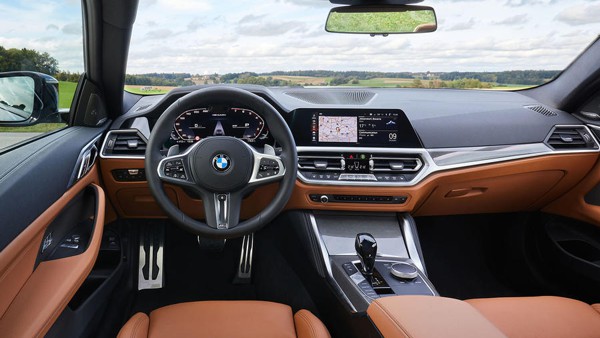 |
|
Modern-looking
and refined cabin
|
|
So the 4-Series coupe is less accommodative than the sedan. It is also
a tad slower. Its handling is marginally sportier, but the ride is
stiffer. Moreover, it costs 7-10 percent more than the equivalent
3-Series. Why do you opt for the Coupe? Most likely, you buy a coupe
primarily for a more attractive look. This rationale stood throughout
the years, from the E36, E46 and E92 3-Series Coupe to the last
generation F32 4-Series Coupe, all looked handsomer than their sedan
siblings. But now you have to think twice. In order to distinguish the
4-Series further from the 3-Series, Munich decided to give the G22 the
boldest and largest double-kidney grille ever. It runs the full height
of the car’s nose, ruining the sleek design theme used to characterize
its predecessors. Market reaction? We have to see, but most BMW fans,
car journalists, testers and even famed designer Frank Stephenson
criticized it heavily. The latter has a good point: how come BMW’s
designers penned a grille so large yet forgot to find a place to put
its number plate? It is an unfortunate design that only its creators
insisted necessary. One excuse is that Chinese customers love big
grille, but the car’s biggest markets are actually the USA and UK.
Once a upon a time, coupes are shorter, lighter, faster, more exciting
to drive and, most important, far more beautiful than the sedans from
which they were derived. This tradition justified the existence of
Italian coachbuilders like Pininfarina, Bertone, Zagato, Touring of
Milan and Ghia. Most of these coachbuilders have gone, and the know-how
of building great coupes has gone with them as well.
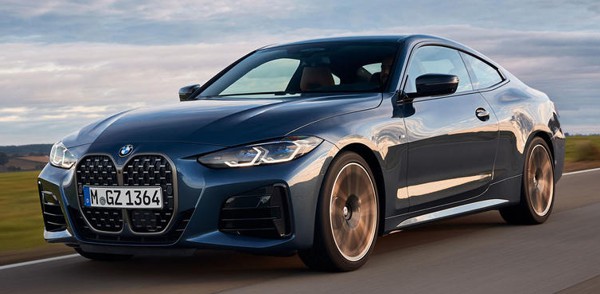 |
|
How
come BMW’s designers penned a grille so large yet forgot to find a
place to put its number plate?
|
|
|
Verdict:     |
Published
on 24
Sep 2021
|
All rights reserved.
|
|
M4 (G82)
|
|
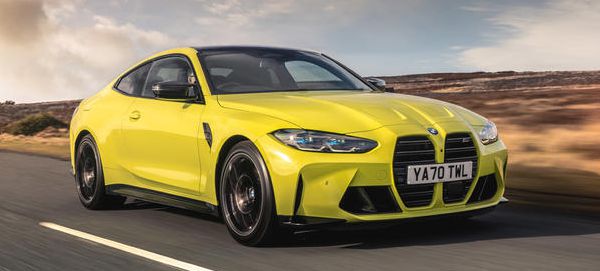
|
|
The
G82 successfully destroyed the only reason to buy the M4 instead of M3:
style.
|
|
Once upon a time, there
was only a 2-door M3. It looked pretty, had a light yet stiff chassis
and accommodated 4 people nicely on board. However, BMW wanted to
broaden its customer appeal, so it added a 4-door option. As the 4-door
M3 sold very well, Munich decided to split the two bodies into M3 and
M4. The latter got a sleeker shape which unfortunately cut rear seat
space without cutting weight or increasing any performance. Now the M4
becomes the less sensible choice. Theoretically, it sells on looks,
which was indeed its biggest asset in the last F82 generation. Somehow,
BMW thought it is time to have a dramatic change for the sake of
change. It added a massive double-kidney grille to cover the full
height of the nose, shaped it in angular and edgy theme to shout even
louder, separate the two kidneys slightly to mirror the poor taste of
some American muscle cars, decorated it with horizontal elements to
emphasize its inelegant flatness. The result? 10 out of 10 automotive
journalists gave negative comments, including those grew up in muscle
car era. The G82 generation successfully destroyed the only reason to
buy the M4 instead of M3.

|
|
While
the roof is set 40mm lower than the M3's, it doesn't benefit center of
gravity.
|
|
Mechanically, the M4 and M3 are identical, even down to suspension
tuning, wheels and tires, wheelbase, track widths etc. Yes, the M4 has
its roof lowered by 40mm, but since the M3 already got a carbon-fiber
roof panel, it helps little to lower center of gravity. What’s more
obvious is the loss in accommodation: the rear seat is so small that no
six-footers would be willing to take a ride longer than 15 minutes.
They are difficult to get on board, too. Although both cars share the
same length, the M4’s boot is 40 liters smaller than that of its 4-door
sibling.
Inside, everything is identical to the M3 except those rear seats.
There is a stylish dashboard design, high-quality materials, tight fit
and finish, first rate infotainment system and all the electronic
driving aids an M-car driver might not need. The seating position is a
bit too high for a 911 driver, but the thick-rim steering wheel is nice
to hold, and the standard M leather seats are comfortable and
supportive. Not so good are the optional carbon-fiber buckets, which
look fantastic but actually too narrow and hard for comfort. No need to
spend £3,000 on them.

|
|
Carbon-fiber
bucket seats are best to be avoided.
|
|
Though annoying, we need to repeat the same technical specifications of
M3 here. All M4 versions employ the S58 3-liter twin-turbo straight-six
already debuted on X3M and X4M. It is rated at 480hp and 406 lbft on
the standard car, mated with 6-speed manual as standard. Competition
model runs higher turbo boost (1.7 instead of 1.3 bar) to achieve
510hp and 479 lbft, the latter mandates ZF 8HP automatic to drive the
rear axle. This car is good for 0-60 in 3.8 seconds. Besides,
Competition can be optioned with M xDrive system, which adds another
50kg to the already substantial kerb weight of 1725 kg, but it cuts
0-60 further to 3.4 seconds, yet it enables a rear-drive drift mode
like M5. No matter which versions, the M4 is only 5kg lighter than the
equivalent M3. That’s why BMW quotes the same performance figures.
In the chassis side, the new Michelin Pilot Sport 4S tires have grown
20mm wider
up front and 10mm wider at the back, guaranteeing tremendous
roadholding. Comprehensive reinforcement at the engine compartment and
underbody achieves a rock-solid foundation for the stiffer suspension
to work on. The rear subframe is rigidly mounted to the body shell to
eliminate slack, improving handling precision and response further.
Active differential, a 10-setting traction control and larger brakes
complete the package.
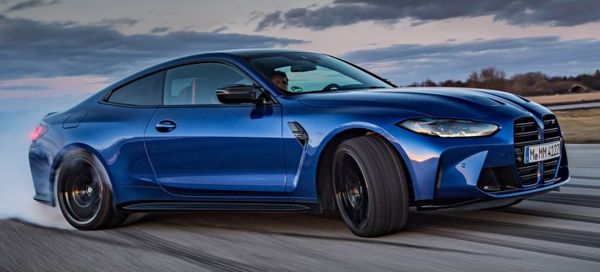 |
|
Dynamically
it is first class, just lacks some subjective qualities...
|
|
As in the M3, you spend a lot of time to explore the endless settings.
Engine response, transmission, exhaust noise, steering, stability,
suspension stiffness and even brake pedal response all have multiple
modes. Fortunately, you can store your favourite combinations in two
shortcut buttons labelled M1 and M2 on the steering wheel. Once done,
the M4 is easy to drive, and drive fast. This car is now as big and
heavy as a Ford Mustang, but the relentless acceleration it
demonstrated runs very close to a Shelby GT500 with 250 more
horsepower. The twin-turbo straight-6 has a very wide power band, and
it responds keenly to throttle once overcome the slight turbo lag shown
below 2500 rpm or so. Yes, the soundtrack is a bit gravelly and
artificial, but it is a very effective powerplant and willing to spin
beyond 7000 rpm. Comparatively, the last generation’s S55 motor felt
more concentrated on mid-range delivery, giving you less reward than
the new motor. The 8-speed automatic shifts seamlessly and accurately
in acceleration, only loses a bit response in rev-matching downshifts
and manual shift speed to the outgoing DCT, but this is largely
compensated by the superior torque and the lack of interruption in
upshift.
The M4 suffers from the same stiff ride as the M3. Poor mountain roads
can transmit too much harshness and noise into the cabin, but fail to
upset its roadholding and balance, which is first rate. The fact that
Car and Driver measured 1.03g on skidpad with a set of pure road tires
is a testament of its great chassis. It feels solid and unflappable.
Grips hard, stays flat and neutral. Maybe not as agile as a true sports
car like 911, but it never feels like a 1725 kg car in any sense.
Steering is not exactly feelsome, but it is quick, accurate and
consistently weighted, so you have faith to lean on. Turn-in is razor
sharp, thanks to those fat front rubbers and tight suspension, yet the
tail exhibits high
level of mid-corner stability. In a fast bend, you can push the tail
out with the new found torque, but it slides more progressively than
the old car and give you plenty of feedback when doing so, something
you cannot say to its predecessor.
Dynamically, the M4 is worth the highest praise. However, it is not as
perfect as we wish for something succeeding the E46 M3 and CSL. It
could ride with more refinement, sings more beautifully and allow you
to choose manual gearbox without sacrificing power. Most important, a
coupe as expensive as this deserves a prettier face. The M4 Competition
starts at
£76,000, a grand more than M3 Competition. Seems that its true
competition comes from internal.
|
Verdict:     |
Published
on 11
Nov 2021
|
All rights reserved.
|
|
4-Series Gran Coupe (G26)
|
|

|
|
The
decision to use a common platform for both combustion and electric
models pay the price on space, on scale and on style.
|
|
Responding to Audi A5
Sportback, BMW created 4-Series Gran Coupe in 2015. You might see it a
4-door version of the 4-Series coupe, or a sportier-looking, hatchback
version of the 3-Series. Anyway, the market received it very well,
buying 860,000 units in 7 years. As a result, BMW developed it into the
second generation.
As before, the Gran Coupe shares the front-end design with the 4-Series
Coupe, including the outrageous full-height kidney grille. An extended
roofline and a pair of extra doors give it proper rear seat
accommodation and access, but it keeps a fastback tailgate and
frameless windows to realize 4-door coupe look. However, compared with
the old car, its new body looks noticeably bulkier. In spite of larger
wheels adopted, the bonnet seems to have lifted further up from the
ground, as is the waistline. Check the spec. sheet and you will find
the new car gets much larger in all dimensions – 145mm longer, 27mm
wider, 46mm longer in wheelbase and, most shockingly, the roof has been
lifted by 53mm to 1442mm. That’s exactly the same as the 3-Series
sedan!
But what’s more unbelievable is that extra height fails to bring any
more headroom. On the contrary, front headroom is reduced by 30mm,
while rear headroom suffers a 15mm reduction from the last generation.
Although the longer wheelbase does boost rear legroom by 30mm, headroom
is the key limiting factor at the rear seat. Basically, if you are 5ft
10 tall, your hair will touch the roof liner. 6-footers are absolutely
ruled out. What happened?
Traditionally, a coupe-style car like this should have their seats
mounted low to compensate for the lower roofline. However, this car
cannot. Why? Because its chassis is used as the basis of BMW’s first
full electric sedan, the i4. The fact that the i4 shares a very similar
appearance with the 4-Series Gran Coupe is not just because of family
genes or coincidence. They share also the same codename, G26. As the i4
has its battery placed under the floor, the 4er GC has a thicker
floorpan as well. That’s why it cannot mount its seats low enough. That
explains also the high waistline and bonnet level, that bulky shape,
that extra weight – yes, the new 430i carries 105 kilograms more than
its predecessor, while M440i, now with xDrive fitted compulsorily, even
gains 210 kg !! Now it is a 1825 kg machine. All thanks to the need of
electrification. Although the 4-Series Gran Coupe will not have an
electric version, the decision BMW taken to use a common platform
(CLAR) for both combustion and electric models pay the price on space,
on scale and on style. It is a lose-lose situation, unfortunately.
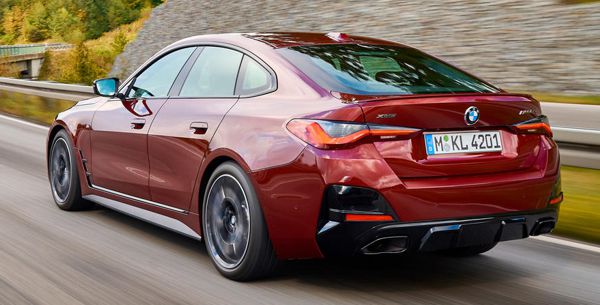 |
|
0-60
takes 4.5 seconds, but when the equivalent M340i xDrive can do it in
4.2 seconds at less money, what can you say?
|
|
So, the new 4-Series GC is uglier, heavier and more cramped inside. It
is also more expensive to buy, because a larger car is inevitably more
costly to build. What about driving dynamics?
Better than expected. Yes, most models get slower due to the extra
weight. In particular, the largest-selling 430i curiously lost 7
horsepower from the old car or 13 horsepower from the equivalent
4-Series Coupe due to emission compliance mods, leaving only 245hp to
haul a 1645kg car. No wonder it takes 0.3 seconds more than the old car
to go from 0-60. The new turbocharged straight-six on M440i is a lot
stronger than the old one, delivering 374hp (or even 382hp in America
without particulate filters) compared with the old car’s 326hp. 4WD
might also help cutting a couple of tenths from standing start. Still,
0-60 is just improved from 4.9 to 4.5 seconds. It is quick, but when
the equivalent M340i xDrive can do it in 4.2 seconds at less money,
what can you say?
Subjectively, the 4-Series Gran Coupe is still a highly polished BMW.
Like the current 3-Series, its strong chassis and redesigned
suspensions with lift-related dampers offer a tight body control and a
firm but tolerable ride, especially if you opt for adaptive dampers. It
offers bags of grip. It balances well and steers eagerly. Although the
steering is not exactly feelsome, it responds responsively and
linearly.
The car feels a lot lighter and more agile than its weight suggested.
With stability control turned off, you may even play with throttle
steer. However, what it does best is GT-thing, cruising rapidly on
highway and stably at fast curves. The engines are smooth, flexible and
refined, particularly the
straight-six, as is the ZF automatic adopted on all models.
In terms of chassis dynamics, the new car is a notable improvement from
the old one. In terms of equipment and build quality, its cabin,
carbon-copy of the 3 and 4-Series, is also
a big improvement. That’s why it is still worth a 4-star rating and the
attention of everyone planning to buy a premium 4-door coupe. However,
the biggest question remains to be what benefits it brings compared
with the equivalent but faster, cheaper and more practical 3-Series. In
the past, your heart instead of brain would choose it. Now with an
uglier face and a bulkier shape, you might need to think twice.
|
Verdict:     |
Published
on 26
Nov 2021
|
All rights reserved.
|
|
i4 (G26)
|
|
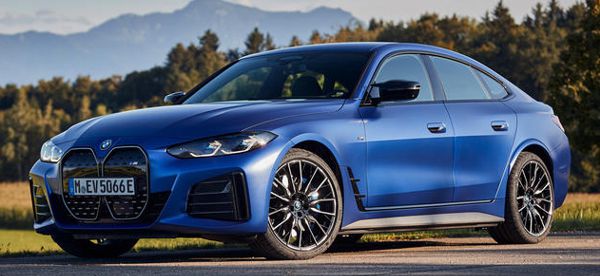
|
|
Munich's
first full electric sedan is derived from the 4-Series Gran Coupe, for
the better and worse of it.
|
|
i4, BMW’s first
all-electric sedan. Where should we start? We can start from the
4-Series Gran Coupe. Many car makers opt for developing dedicated
platforms for electric cars. BMW tried that as well in i3 and i8, but
they were not exactly commercial success. In the end, Munich decided
that its next generation electric cars should spread cost with its vast
range of conventional cars. That resulted in the flexible CLAR
platform, which was designed to accept ICE, plug-in hybrid as well as
battery power. The i4, Munich’s response to Tesla Model 3, is derived
from the new 4-Series Gran Coupe. It shares even the same codename G26,
no wonder you can see they look almost the same from outside. In fact,
they share identical length, width and wheelbase. Only 6mm extra height
differ the i4 from its fuel-powered sibling.
This is not a handsome car. As I have pointed out in the review of 4er
GC, the car looks too bulky for what is supposed to be a 4-door coupe.
Its tallness and unusually high waistline are certainly the result of
putting the battery under floor, but BMW’s design team should take
blame as well. A Tesla Model 3 is actually as tall, but you won’t feel
that, because it has a low and gently rising waistline. If you lower
the waistline and enlarge the greenhouse, the car will look much lower,
lighter and smaller. The lack of an engine up front allows Tesla to use
a low and sweeping bonnet to realize that magic, but in the case of
BMW, the need to accommodate an engine for 4er GC makes it impossible
to lower the bonnet. Still, I think if BMW opted for a coke-bottle
flowing waistline rather than a straight one, if it abandoned the
vertical kidney grille for something slimmer and more pointed, or if it
was willing to retrofit the i4 with a less pronounced bonnet and
tailor-made front fenders, the car could have looked slimmer and
handsomer. There are many ways to make this car look better, just
ignored by BMW’s design team.
Much better is the engineering, traditional strength of Munich.
Remarkably, the CLAR platform of 4-Series Gran Coupe allows most of the
batteries to be placed under the floor like a dedicated EV platform.
Only 2 smaller modules are housed within the front half of the
transmission tunnel, which does not rob any passenger space. BMW also
makes good use of the transmission tunnel to house cabling and the
space under the rear seat originally reserved for fuel tank to place
charger and heating/cooling facilities for the battery. The lithium
battery is NMC type and offered in only one size, 83.9kWh gross. That’s
slightly more than Tesla Model 3 Long Range, although the Tesla uses
energy more efficiently thus returns slightly longer range.
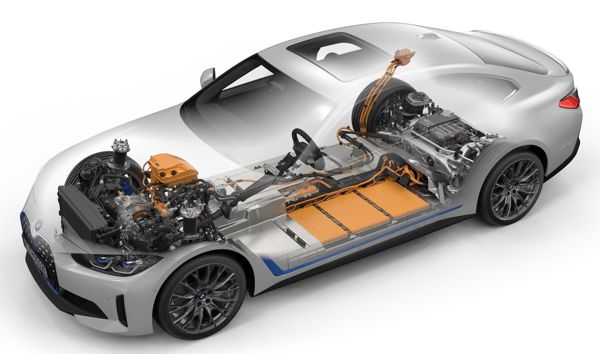
|
|
Brilliantly,
BMW managed to fit all batteries into the floorpan and transmission
tunnel of the CLAR platform.
|
|
The entry-level eDrive40 runs a single, rear-axle motor with 340
horsepower, good for 0-60 in 5.4 seconds but top speed is limited to
just 118 mph. WLTP range is a remarkable 590 km (367 miles). Meanwhile,
performance model M50, which is the first ever M-badged electric car,
uses front and rear motors to deliver a combined 544 horsepower, 0-60
mph in 3.8 seconds (matching the new M3 Competition), 140 mph top speed
and 510 km (317 miles) range. They are priced at £53,000 and
£64,000, respectively, slightly more expensive than the
equivalent Model 3 Long Range and Performance. BMW designed its
electric motors inhouse. They are electrically excited synchronous
motors, using no rare earth. Inverter and single-single gearbox are
integrated with each motor. Both cars support 200kW DC quick charging,
which can take the battery from 10 to 80% in half an hour.
Thanks to the floor-mounted battery, the eDrive40 has a center of
gravity 53mm lower than that of a 3-Series, but it tips the scale at
2050kg, 400kg more than the equivalent 430i Gran Coupe. With another
motor and running gear installed up front, the M50 is heavier still at
2215kg, and its center of gravity is raised by 16mm. However, the car
is very well balanced with 48:52 weight distributed between front and
rear axle. The M50 also gets some chassis upgrades, not only larger
wheels and tires but also extra reinforcement bracings in the engine
compartment (ok, “front motor compartment” maybe) and rear suspension.
Its front and rear track are widened by 26mm and 12mm, respectively,
and the suspension gets more negative camber. Speaking of suspensions,
they are basically the same as the 4er GC, but retuned to take care of
the extra weight. The M50 gets adaptive dampers and, unusually, air
springs at its rear axle as standard.
On the Road
BMW CEO Oliver Zipse said Tesla is not a premium car maker. If you
compare the interior of Model 3 with this one, you will certainly agree
with him. While the Tesla looks plain, full of cheap materials and
ill-fitted parts, the i4, like 4er GC and 3er, feels high-quality,
plush and desirable. The majority of its interior is shared with its
siblings, but it gets a unique curved panel display which combines a
12.3in instrument and 14.9in touchscreen seamlessly. The graphic looks
crisped, the infotainment system responds without delay, the user
interface is well thought out. You can control the system through
touchscreen, voice control, steering wheel mounted controls or the
conventional iDrive rotary control on transmission tunnel. In terms of
space, it is just the same as the 4-Series Gran Coupe. This means rear
head room is compromised by the swoopy roof line, and rear foot room is
limited due to the placement of battery underfloor. On the plus side,
you get plenty of room up front. The driver seat is supportive and
mounted low enough. As for luggage, the 470-liter trunk loses just 10
liters from the 4-Series. Its hatchback design and 40/20/40-split rear
seat are more convenient for luggage carrying.
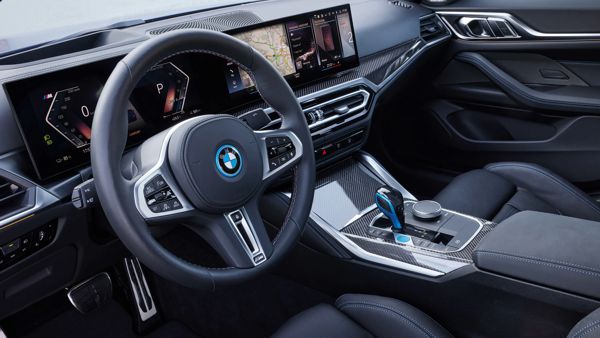
|
|
A
curved panel display marks it out from its 4 and 3-Series siblings, but
otherwise the interior is equally classy.
|
|
The dual-motor powertrain of the M50 model is impeccably calibrated to
deliver a strong yet smooth acceleration. It can produce a continuous
476 hp, or overboosted to 544 hp for up to 10 seconds in Sport mode.
Low-speed acceleration feels just as strong as that of an M3
Competition, thanks to zero delay throttle and instant torque. However,
that sense of punch begins to tail off at 3-figures speeds, as the
single-speed gearboxes are not optimized for Autobahn challenge.
Without exhaust and induction noises, does the i4 feel boring to drive?
Better than expected, because BMW’s acoustic engineers partnered with
composer Hans Zimmer to create an artificial soundtrack that changes
tone and volume according to throttle and speed. It sounds suitably
exotic. Turn off the speakers, however, you will find the i4
impressively quiet, free of motor whine and wind noise. That's a night
and day difference from the noisy cabin of Tesla.
The same refinement can be found in its ride quality, which is firm but
compliant and quiet, just like its 4-Series sibling. Likewise, handling
is very good for an electric car. Excluding hard acceleration or
extreme maneuvering, the i4 is largely driven by rear wheels and
therefore feels neutral in cornering. Push harder, you feel the front
axle gets into play and offer extra traction. Its steering lacks the
clarity of a true M-car, but it places the nose precisely, belying the
2.1-ton weight. Body control is better than Model 3 Performance, feels
more composed and unflustered by mid-corner bumps. Like Porsche Taycan,
its braking is expertly calibrated, combining regenerative and
mechanical braking smoothly. Moreover, you can adjust the level of
regenerative braking, so one-pedal driving is possible.
Having said that, don’t forget the M50 carries 450kg more than an M340i
xDrive, and it lacks a limited slip differential. Push it really hard
in the twisty, or change direction suddenly, you will find it responds
slower, more easily pushed into understeer. On a wet tight corner, it
is more prone to spin its inside rear wheel as it struggles for
traction under the strong motor torque. This means, the M340i remains
our favourite mid-price performance sedan, while the i4 M50 is a better
4-door GT for cruising, provided you can live with its 140 mph top
speed, the need of recharge and the relatively high price.
|
Verdict:     |
Published
on 27
Oct 2022
|
All rights reserved.
|
|
M4 CSL (G82)
|
|
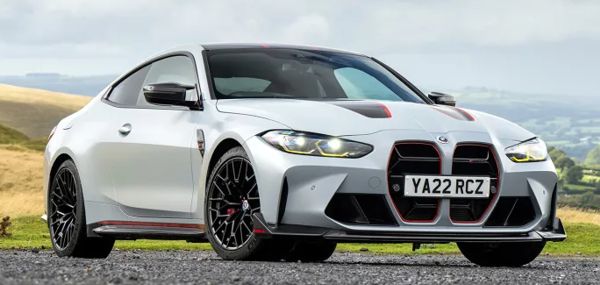
|
|
40
hp up and 100 kg down from standard car don't transform it into the GT3
of BMW.
|
|
There were only 2 BMW
models carried the prestigious CSL badge before, one was the 3.0CSL of
1971, another was M3 CSL (E46) of 2003. Back then, CSL stood for Coupe
Sport Lightweight, not Competition Sport Lightweight as of today. The
last letter was evident from their use of lightweight materials and
stripped out construction. The 3.0CSL, created for homologating touring
car racing, had a body made of aluminum, thinner gauge steel and
plexiglass, while its interior ditched virtually all creature comfort
for a kerb weight of 1165 kg, more than 200 kg lighter than the 3.0CS
from which it was derived. The M3 CSL used similar technique – albeit
now with carbon-fiber and aluminum honeycomb – to slash 110 kg from the
regular M3 for a kerb weight of 1385 kg. Both cars enjoyed increased
power and beefed up chassis as well.
The new M4 CSL follows much the same formula. It cuts 100 kg from the
M4 Competition on which it is based, thanks to a series of weight
saving measures. Half of that comes from stripping out the cabin, such
as sound insulation (15 kg) and rear seat (21 kg), replacing the
standard electric seats with fixed carbon-fiber buckets (24 kg).
Then, the chassis cuts 21 kg by using ceramic brakes, lightweight alloy
wheels, springs and struts. Titanium exhaust also saves 4 kg, while
carbon-fiber bonnet and boot lid slash 11 kg. Even small details like
the
double-kidney grille, rear lights, floor mats and air-con are altered
to shave off
another 4 kg. All sound very exotic, but don’t
forget the G82 M4 is seriously overweight, so after the strict diet the
CSL still tips the scale at the wrong side of 1625 kg. In other words,
lighter but not exactly lightweight. Having said that, in an era when
Lotus Evija hypercar can weigh 1680 kg, perhaps BMW has the right to
keep the L letter.
BMW has not altered the S58 twin-turbo straight-six though, just
rewrote ECU codes
to increase maximum boost pressure from 1.7 to 2.1 bar. As a result,
horsepower increases by 40 to 550 at 6250 rpm. Max. torque
stays unchanged at 479 lbft, but it is available across a wider band,
from 2750 rpm all the way to 5950 rpm. The ZF 8-speed automatic
transmission has been recalibrated to shift faster at sportier modes.

|
|
In
an era when Lotus Evija hypercar can weigh 1680 kg, perhaps BMW has the
right to keep the L letter.
|
|
Being strictly rear-drive, the CSL won't match the lesser M4
Competition xDrive in most acceleration indicators. It will do 0-60 in
3.6 seconds and 124 mph in 10.7. However, the latter is good enough to
match the current 992 GT3, so it is still a very very fast car without
question. Its top
speed is restricted to 191 mph.
As for chassis modifications, the front structure is reinforced by an
aluminum frame bolted across the suspension towers and the front end.
The suspension gets specific camber, spring and damper setting, while
ride height is dropped by 8mm. Wheels and tire sizes remain the same,
but shod with semi-slick Michelin Cup 2R tires as standard, although
road-going
Pilot Sport 4S tires are no cost option. Outside, the CSL can be
spotted from a different kidney grille that does without horizontal
elements, more aggressive front splitters with end plates and a more
pronounced boot lid spoiler that cuts lift.
Thanks to all these modifications, the CSL lapped the old 20.6 km
course of Nurburgring in 7:15.7, faster than any other BMWs road cars.
It still
trails 911 GT3 by 20 seconds though.
On th Road
The CSL’s engine is not a marked difference from the standard unit.
There is certainly more mid-range punch, but it also feels more boosty
as a result. Unlike the twin-turbo V6 of Alfa Romeo Giulia GTA, which
is responsive, linear, hungry for rev and will reward you with greater
sound as rev climbs, the BMW straight-six is more effective than
charismatic. Yes, it
is much stronger at mid-range, but it is also laggier low down. The
flat torque curve means not much rewards to have for chasing redline –
although it doesn’t mind to spin beyond 7000 rpm. Nor its exhaust note
especially encouraging to do so. Angry bark on overrun exists, but not
particularly thrilling elsewhere. In short, the CSL engine is an
incremental upgrade from the regular M4 rather than a step change.
Likewise, the ZF automatic is effective rather than outstanding. It
works well on the regular M4 and unquestionably will do perfectly on
any 4-door sports
sedans, but for a car as purposeful as the CSL, its limitation is
exposed. By remapping it to shift faster than ever, the shifts are not
as slick as they should be. Sometimes downshifts fail to keep up, too.
A DCT would be a better answer.
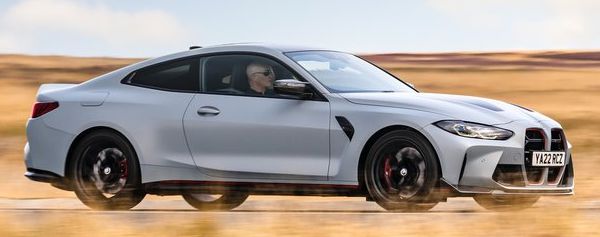
|
|
Very
fast on road and track? Yes, but the CSL badge deserves more driver
engagement.
|
|
Handling depends very much on which tires you opt for. On Cup 2Rs, it
drives like a dream. Phenomenal grip allows it to corner as if on
rails. Razor-sharp turn-in, accurate (if still not exactly feelsome)
steering, fantastic braking. It also behaves progressively at the
limit. However, the semi-slick rubbers need a dry track and adequate
warm up to work properly. They are also prone to wear out quickly. It
is therefore unfair to compare with rivals shod with road tires.
Conversely, the Pilot Sport 4S tires are less remarkable, but more
suitable to daily road use. So equipped, the CSL still delivers plenty
of traction and grip, but again it doesn’t feel a step change from the
M4 Competition. Yes, the steering and turn-in are more incisive due to
the stiffer front end. The body control is a little better, likewise
the braking, but the car’s balance and character are mostly unchanged,
unlike a 911 GT3 to a regular Carrera. Strangely, the CSL does not fill
the huge gap between the 2 tire options with Cup 2, which is the choice
of most rivals and
very likely the best of both worlds.
On the plus side, the CSL loses little ride comfort and refinement. Its
suspension is not as stiff as expected. In fact, at softer damping
modes it will be happy to ride on back roads. The noise level in cabin
is also not as bad as thought. Overall comfort is definitely better
than the Porsche GT3 and GT4 RS, cementing BMW’s intention to market
the M4 as a GT.
Nevertheless, for a car reusing the CSL badge, it is still a
disappointment. The CSL is supposed to be the
purist’s choice and deserves more driver engagement. As it is not, the
£129,000 starting price is hard to justify. That's a whopping 70
percent more expensive than the M4 Competition, and more than many
thoroughbred sports cars that offer purer driving experience, let alone
a prettier face. In fact, just as expensive as the mighty 911 GT3.
|
Verdict:    |
Published
on 6
Jun 2025
|
All rights reserved.
|
|
M4 CS (G82)
|
|

|
|
BMW
testing the upper limits of the M4, for both performance and pricing.
|
|
How to describe the M4 CS
? It is something midway between the M4 Competition xDrive and the
1000-units limited edition M4 CSL. Alternatively, you might simply call
it the coupe version of M3 CS. If you know all these cars well, you’ll
have zero difficulty to understand the M4 CS in a few minutes.
Engine first: it reuses the CSL’s 550 hp version of S58 twin-turbo
straight-six. The hardware is actually the same as that serving the
lesser Competition, but turbo boost pressure is dialed up to 2.1 bar,
liberating another 40 horsepower – well, should be 20 only, as the
Competition has been boosted to 530 hp since its recent facelift. Peak
torque is still limited by the ZF automatic gearbox to 479 lbft, but it
is available across a wider rev range.
Drivetrain: unlike the CSL which ditches 4-wheel drive for maximum
weight saving, the CS keeps xDrive system onboard. This means you can
rely on its superior traction to outdrag the CSL. 0-60 mph is quoted at
3.3 instead of 3.6 seconds, but even that is on the conservative side,
as Autocar timed just 2.9 seconds. Another benefit of the xDrive is its
all-round handling. It is normally driven by the rear wheels, but the
multi-plate clutch will send power up front immediately if it senses
the rear spinning. You can alter the tendency of torque transfer hence
the balance of the car by changing drive mode. Extra weight aside, the
xDrive actually contributes to better handling, especially on
challenging roads.
Weight saving: it adopts the CSL’s many carbon-fiber parts, such as
bonnet, aero kits, door mirrors, bucket seats and dash trim (in
addition to the standard car’s carbon roof panel). It also gets the
CSL’s lightweight forged alloy wheels and titanium exhaust, but not its
ceramic brakes, which is an £8800 option here. The CSL’s diet
went as extreme as ditching the rear seat and most of the sound
insulation, but the CS keeps these for a more road-usable manner. It
also skips the CSL’s carbon boot lid with ducktail spoiler, making the
CS more difficult to be distinguished from lesser M4 models. Overall,
the CS is just 15 kilograms lighter than the Competition xDrive. At
1760 kg, it is by no means a lightweight.

|
|
0-60
mph in 2.9 seconds is staggering. It can challenge 911 Carrera S or
even GTS on most roads.
|
|
Chassis modifications: compared with Competition, springs are stiffened
by 3 percent up front and 5 percent at the rear, which is less
aggressive than the CSL. The adaptive dampers are retuned to suit, as
are the anti-roll bars which use rose joints. The front suspension gets
increased negative camber to enhance cornering grip and turn-in bite. 3
choices of tires are available: Michelin PS 4S (for road use), Cup 2
(for road and track) and Cup 2 R (for track only). Fitted with the
latter, the M4 CS timed 7:22 lapping the new 20.8km course of
Nurburgring, just 3 seconds longer than the CSL. It is 6.8 seconds
quicker than the mechanically similar M3 CS. Maybe tires are different
in those tests.
Undoubtedly, the M4 CS is a very quick and serious performance coupe,
one could challenge a 911 Carrera S or even GTS on most roads.
Unfortunately, it is also as expensive as those Porsches. At
£130,000 with ceramic brakes fitted, it is actually as expensive
as the CSL, too, which doesn’t sound a good investment for an unlimited
production derivative of a mass production coupe. The 911s might not be
quicker, but they do feel sportier and more eager to turn and dance due
to lighter weight and lighter nose, and their boxer engines feel more
responsive to throttle and more willing to rev to the top end than the
boosty BMW straight-six.
In isolation, the CS feels like a 5-star car, but compared with its
rivals – all are very special cars at this price point and, don’t
forget, many of them are thoroughbred sports cars – it is probably not
special enough. The E46 M3 coupe used to be renowned for performance
bargain at under £40K. That was a long time ago, of course, but
stretching to £130K, even at today’s money, is still too
expensive for the BMW and 4-Series badges. It would be more sensible to
stick with the £90K Competition xDrive or wait for the order book
opens for the £87K M2 CS.
|
Verdict:     |
|